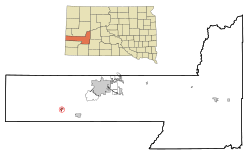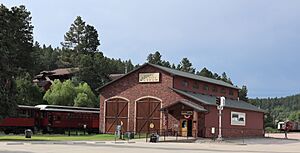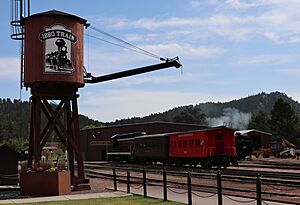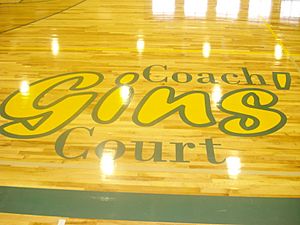Hill City, South Dakota facts for kids
Quick facts for kids
Hill City
|
|
|---|---|
 |
|
| Motto(s):
The Heart of the Hills
|
|

Location in Pennington County and the state of South Dakota
|
|
| Country | United States |
| State | South Dakota |
| County | Pennington |
| Established | 1876 |
| Incorporated | 1945 |
| Government | |
| • Type | Mayor-Council |
| Area | |
| • Total | 1.32 sq mi (3.42 km2) |
| • Land | 1.31 sq mi (3.40 km2) |
| • Water | 0.01 sq mi (0.02 km2) |
| Elevation | 5,013 ft (1,528 m) |
| Population
(2020)
|
|
| • Total | 872 |
| • Density | 664.63/sq mi (256.63/km2) |
| Time zone | UTC−7 (MST) |
| • Summer (DST) | UTC−6 (MDT) |
| Zip Code |
57745
|
| Area code(s) | 605, NXX Exchange 574 |
| FIPS code | 46-29100 |
| GNIS feature ID | 1267423 |
| Website | City of Hill City |
Hill City is the oldest existing city in Pennington County, South Dakota, United States. The population was 872 at the 2020 census. Hill City is located 26 miles (42 km) southwest of Rapid City on U.S. Highway 16 and on U.S. Route 385 that connects Deadwood to Hot Springs. Hill City is known as the "Heart of the Hills", a distinction derived from its proximity to both the geographical center of the Black Hills, and the local tourist destinations.
The city has its roots in the Black Hills mining rush of the late 19th century. Tin mining was dominant in the 1880s and led to an influx of capital and people into the area. As the mining industry waned, tourism and timber became increasingly important industries to the area. With the establishment of Mount Rushmore in the 1940s, Custer State Park and the Sturgis Motorcycle Rally, the Black Hills became known as a tourist destination, from which Hill City benefited. In recent years, the city has diversified to become a center for the arts in the area, featuring several art studios and festivals.
Contents
History
Human history in the area that became Hill City, and the greater Black Hills in particular, started by at least 7000 BC. The Arikara arrived by 1500 AD, followed by the Cheyenne, Crow, Kiowa and Pawnee. In the 19th century, the Lakota Sioux claimed the land, calling it Paha Sapa. In 1874, Major General George Armstrong Custer led an expedition into the Black Hills, during which gold was discovered in French Creek, 13 miles (21 km) south of Hill City. The discovery of gold opened the Black Hills, and the Hill City area, to mining. Hill City was first settled by miners in 1876, who referred to the area as Hillyo. This was the second American settlement in the Black Hills. Hill City is the oldest city still in existence in Pennington County. A post office was constructed and opened on November 26, 1877. The city almost became a ghost town when miners relocated to the northern Black Hills after the discovery of gold there.
In 1883, tin was discovered near Hill City, and the population rebounded. The Harney Peak Tin Mining, Milling, and Manufacturing Company made its headquarters on Main Street. The company was backed by English financiers and bought 1,100 prospecting sites around the area. As mining grew, the city became known for its wild living and was once referred to as "a town with a church on each end and a mile of Hell in between." At one time, 15 saloons were located on Main Street. The company built the Harney Peak Hotel on Main Street to entertain its management and executives. Upon realizing the tin market was unsustainable, the company ceased operation in 1902.
Although a small school building was established previously, a main school building was constructed on Main Street in 1921. This school building was replaced in 2001 with the current high school. On July 10, 1939, a fire started 10 miles (16 km) outside of Hill City. Among those who battled the blaze was Hill City High School's entire basketball squad, as well as several teachers and administrators. The United States Forest Service named the school boys one of the best crews who fought the fire. The school team name thus became the Hill City Rangers and was privileged as the only school district in the United States allowed to use Smokey Bear as its official mascot. Hill City was incorporated on March 21, 1945. The Harney Peak Hotel remained in operation until 1934. The building has been restored and is the current location of the Alpine Inn. This building is on the List of Registered Historic Places in South Dakota. The Black Hills Institute of Geological Research opened in 1973 and is involved in the excavation and display of dinosaur and other fossils. In 1992, the institute was engaged in a legal battle over ownership of the Tyrannosaurus rex fossil named "Sue".
This city was one of the filming locations for TNT's 1994 film Lakota Woman: Siege at Wounded Knee.
Railroad
The main railroad lines that intersected Hill City were the Burlington Northern Line (also called the High Line), previously the Grand Island and Wyoming Central, operated by the Chicago, Burlington and Quincy Railroad Company; and the Black Hills Central Line, a spur that extended from Hill City to Keystone. The High Line extended from Edgemont north through Hill City and terminated in Deadwood. This line reached Hill City in 1893, and the Black Hills Central Line was extended and reached Keystone on January 20, 1900. Narrow gauge trolley cars were operated at 45-minute intervals during the day on the High Line. The High Line discontinued its passenger service in 1949 and was fully abandoned in 1983. It is now the George S. Mickelson Trail, after being converted to a bike trail during the 1990s.
In 1957, the Black Hills Central Railroad, also known locally as the 1880 Train, opened a tourist passenger train on the Black Hills Central Line. In 1972, a flood destroyed the last mile of the Burlington Northern and Black Hills Central Lines that extended from Hill City to Keystone. This final mile was restored in 2001. The Black Hills Central Railroad restores era-style locomotives and train cars. It has been featured on television shows such as the Gunsmoke episode "Snow Train", General Hospital, and the TNT mini-series Into the West. The railroad also made an appearance in the movie Orphan Train.
Geography and climate
Hill City is located in the Black Hills near the geographic center of the Black Hills, which is where the cities motto "The Heart of the Hills" originated. Spring Creek and Newton Fork run through the east side of town.
According to the United States Census Bureau, the city has a total area of 1.27 square miles (3.29 km2), of which 1.26 square miles (3.26 km2) is land and 0.01 square miles (0.03 km2) is water.
The climate of Hill City is dry, with an average of 20 inches (510 mm) of precipitation annually. The presence of the hills surrounding the town leads to cooler weather in winter and summer and makes for calm conditions with little wind compared to areas outside of the Black Hills. The Köppen climate type of this location is Dwb, often described as the dry-winter version of the Warm Summer Humid Continental climate. Climates that feature a winter dry season like this one are rare in non-tropical areas of the United States, with appearances limited to isolated areas of the Great Plains states.
| Climate data for Hill City, South Dakota (1991–2020 normals, extremes 1968–present) | |||||||||||||
|---|---|---|---|---|---|---|---|---|---|---|---|---|---|
| Month | Jan | Feb | Mar | Apr | May | Jun | Jul | Aug | Sep | Oct | Nov | Dec | Year |
| Record high °F (°C) | 74 (23) |
70 (21) |
77 (25) |
85 (29) |
90 (32) |
99 (37) |
101 (38) |
101 (38) |
98 (37) |
89 (32) |
78 (26) |
71 (22) |
101 (38) |
| Mean maximum °F (°C) | 59.8 (15.4) |
59.2 (15.1) |
67.4 (19.7) |
74.4 (23.6) |
82.5 (28.1) |
89.4 (31.9) |
93.0 (33.9) |
91.7 (33.2) |
88.2 (31.2) |
79.1 (26.2) |
67.7 (19.8) |
58.9 (14.9) |
94.3 (34.6) |
| Mean daily maximum °F (°C) | 40.5 (4.7) |
40.8 (4.9) |
49.0 (9.4) |
55.8 (13.2) |
64.8 (18.2) |
75.4 (24.1) |
82.8 (28.2) |
81.8 (27.7) |
73.8 (23.2) |
59.8 (15.4) |
48.6 (9.2) |
40.7 (4.8) |
59.5 (15.3) |
| Daily mean °F (°C) | 25.1 (−3.8) |
25.5 (−3.6) |
34.0 (1.1) |
41.1 (5.1) |
50.7 (10.4) |
60.3 (15.7) |
66.7 (19.3) |
65.0 (18.3) |
56.2 (13.4) |
43.8 (6.6) |
33.2 (0.7) |
25.4 (−3.7) |
43.9 (6.6) |
| Mean daily minimum °F (°C) | 9.6 (−12.4) |
10.1 (−12.2) |
19.1 (−7.2) |
26.3 (−3.2) |
36.6 (2.6) |
45.2 (7.3) |
50.7 (10.4) |
48.3 (9.1) |
38.5 (3.6) |
27.9 (−2.3) |
17.8 (−7.9) |
10.2 (−12.1) |
28.4 (−2.0) |
| Mean minimum °F (°C) | −14.7 (−25.9) |
−14.3 (−25.7) |
−4.5 (−20.3) |
8.4 (−13.1) |
21.4 (−5.9) |
32.2 (0.1) |
39.5 (4.2) |
36.6 (2.6) |
24.3 (−4.3) |
8.5 (−13.1) |
−3.7 (−19.8) |
−12.9 (−24.9) |
−23.8 (−31.0) |
| Record low °F (°C) | −30 (−34) |
−38 (−39) |
−25 (−32) |
−9 (−23) |
14 (−10) |
26 (−3) |
30 (−1) |
28 (−2) |
12 (−11) |
−21 (−29) |
−19 (−28) |
−39 (−39) |
−39 (−39) |
| Average precipitation inches (mm) | 0.40 (10) |
0.65 (17) |
1.12 (28) |
2.46 (62) |
4.15 (105) |
3.43 (87) |
3.55 (90) |
2.34 (59) |
1.54 (39) |
1.65 (42) |
0.59 (15) |
0.49 (12) |
22.37 (568) |
| Average snowfall inches (cm) | 6.1 (15) |
8.7 (22) |
11.6 (29) |
13.8 (35) |
4.1 (10) |
0.3 (0.76) |
0.0 (0.0) |
0.0 (0.0) |
1.0 (2.5) |
6.5 (17) |
7.5 (19) |
7.0 (18) |
66.6 (169) |
| Average precipitation days (≥ 0.01 in) | 5.1 | 6.6 | 7.4 | 10.8 | 14.3 | 12.4 | 12.2 | 10.1 | 7.6 | 7.8 | 5.0 | 5.1 | 104.4 |
| Average snowy days (≥ 0.1 in) | 4.8 | 6.0 | 5.7 | 5.3 | 1.2 | 0.1 | 0.0 | 0.0 | 0.4 | 2.1 | 4.0 | 4.7 | 34.3 |
| Source: NOAA | |||||||||||||
Demographics
| Historical population | |||
|---|---|---|---|
| Census | Pop. | %± | |
| 1890 | 470 | — | |
| 1910 | 271 | — | |
| 1950 | 361 | — | |
| 1960 | 419 | 16.1% | |
| 1970 | 389 | −7.2% | |
| 1980 | 535 | 37.5% | |
| 1990 | 650 | 21.5% | |
| 2000 | 780 | 20.0% | |
| 2010 | 948 | 21.5% | |
| 2020 | 872 | −8.0% | |
| U.S. Decennial Census | |||
2010 census
As of the census of 2010 there were 1008 people, 394 households, and 244 families residing in the city. The population density was 752.4 inhabitants per square mile (290.5/km2). There were 473 housing units at an average density of 375.4 per square mile (144.9/km2). The racial makeup of the city was 82.1% White, 0.6% African American, 4.0% Native American, 0.1% Asian, 10.4% from other races, and 2.7% from two or more races. Hispanic or Latino of any race were 18.9% of the population.
There were 394 households, of which 33.0% had children under the age of 18 living with them, 49.2% were married couples living together, 7.9% had a female householder with no husband present, 4.8% had a male householder with no wife present, and 38.1% were non-families. 30.7% of all households were made up of individuals, and 9.7% had someone living alone who was 65 years of age or older. The average household size was 2.41 and the average family size was 3.05.
The median age in the city was 37.9 years. 25.8% of residents were under the age of 18; 8.7% were between the ages of 18 and 24; 24.7% were from 25 to 44; 27.6% were from 45 to 64; and 13.4% were 65 years of age or older. The gender makeup of the city was 51.2% male and 48.8% female.
Economy
Employment in Hill City is based on the timber, tourism, and telecommunications industries. The timber industry is important to Hill City since it is located in the Black Hills National Forest. Rushmore Forest Products used to operate a lumber mill outside of town and was the area's largest employer until it closed down in 2021.Tourism is enabled by Hill City's proximity to Mount Rushmore, Crazy Horse Memorial, Custer State Park, and the Sturgis Motorcycle Rally. Several local attractions, restaurants, souvenir shops, and art galleries cater to those visiting the area. RMA & Associates, a telecommunications company responsible for telephone surveying, has a call center in Hill City.[1]
Hill City has increasingly become the arts community of the Black Hills, and is the home to the Warrior's Work gallery, which features both Indian art and art reflecting the West, Black Hills Bronze, and the home gallery of well-known local painter Jon Crane. It is also the home of Art of the Hills magazine, which focuses on the art and artists of the region.
Hill City collects a 2% sales tax on general merchandise, and an additional 1% on lodging, restaurants, alcohol, and ticket sales. Hill City does not tax income on business or individuals.
Education
Hill City School District 51-2, the area school district, is made up of elementary, middle, and high schools located in separate buildings on the same campus. A permanent school building was constructed in 1921 and housed all grades until an elementary school building was constructed in 1961 with several modifications in the 1980s. The Middle School was built in the 1970s with several additions in the 1990s. After the middle school was built the original school building became the high school building. In 2001, construction was begun on a new high school which was completed in 2002. The previous high school was razed in 2003. Hill City District 51-2 schools are predominantly funded through property tax on those living in the school district. The district also has adopted an open enrollment policy that makes it easier to transfer between local school districts.
Enrollment as of the 2010–2011 school year was 506, while the majority live outside the city limits. The school also serves the town of Keystone, South Dakota, and the unincorporated towns of Rochford, and Silver City. The school system is administered by a board of education which as of the 2010–2011 school year, was made up of President Owen Wiederhold and members Cydnee Gruzenski, Kris Knapp, Darrell Sullivan and Michelle Anderson. The school's superintendent is Mike Hanson. The high school principal is Todd Satter, the middle school principal is Blake Gardner, and the elementary principal is Chip Franke.
The Hill City Schools made AYP under the No Child Left Behind Legislation at every grade level and at every subgroup. South Dakota school districts use the Dakota Step Test as its assessment tool. The upcoming year, 79% of students will be required to be proficient in reading and 72% in math.
Culture and religion
Hill City is becoming a center for the Black Hills visual arts community. The Hill City Arts Council oversees the promotion of the arts in the city, as well as several arts events throughout the year including the annual Art Extravaganza put on by the local artists and Arts and Crafts fair which draws more regional influence. An annual quilt show and Native American quilt show are also offered. There are seven art studios and galleries in town with several regionally known artists. Styles highlighted are sculpture in bronze and stone, watercolors, painting, and framing. Native American artwork and jewelry are also prominent.
The Hill City Slickers is a musical group that plays country, folk, and bluegrass music as well as original music. In 2003 they were featured artists with the Black Hills Symphony Orchestra. Thus far they have produced three albums.
Hill City is home to the Black Hills Museum of Natural History, which came out of the vision of the Black Hills Institute for Geological Research. The museum was incorporated in 1992. The collection on display includes dinosaurs, fossil fishes, mammals, birds, reptiles, and fossil invertebrates, as well as gemstones, minerals, and meteorites. The highlight of the collection is the Tyrannosaurus rex specimen named "Stan" which is one of the most compete skeletons unearthed with 65% of the bones unearthed. The museum is also a leading contributor to Hill City's Natural History Days celebration that focuses on fun and education, with guest speakers, and a fossil hunt for children.
Wade's Gold Mill and Mining Museum offers a look back on the history of mining in the Black Hills. The museum has worked to collect and preserve equipment used of mining in the Black Hills and hosts a one-stamp gold mill.
Although people of many faiths live in Hill City, five groups have established church buildings in town. These include Assemblies of God, Catholic Church, Lutheran Church–Missouri Synod, Evangelical Lutheran Church in America, and one non-denominational Christian church.
Sports and recreation
Hill City High School is a member of the South Dakota High School Activities Association and competes in class "A". Because students helped to fight a wildfire that threatened the community in 1939, the school's mascot is Smokey Bear, and the fight song is Marines' Hymn. High School Boys compete in basketball, football, track and field, cross country, and wrestling. High School Girls compete in basketball, volleyball, cheerleading, track and field, cross country, and golf. The school also provides a choir, band, and theatre department.
Outdoor Sports popular in the area include hiking, mountain climbing, snowmobiling and dogsled racing. Hill City is the ninth trailhead on the George S. Mickelson Trail that runs from Deadwood, to Edgemont. This trail is often used for running, cycling, and snowmobiling in the winter.
Snowmobiling is also enjoyed in the area with groomed paths running through Hill City and the surrounding Black Hills. There are 350 miles (560 km) of groomed trails in the area. Two snowmobiling magazines have rated the Black Hills as one of the best places to ride in North America.
Notable people
- Frank Henderson, jurist and state legislator
- Jonathan Karl, American politician; ABC News Washington Correspondent; raised in Hill City.
- Watson Parker, historian specializing in the history of the Black Hills; raised on a ranch near Hill City.
Area Media
The television and radio stations available in Hill City are generally based out of the Rapid City market. Hill City does have one FM station, 103.9 K280AJ, which is a translator station of KRCS Sturgis.
- Television
- FM Radio
- 89.3 KBHE SDPB/NPR (Public/Classical/Jazz)
- 92.3 KQRQ-FM "Q 92.3" (Classic hits)
- 93.1/99.5 KRCS "Hot 93.1" (Top 40/CHR)
- 93.9 KKMK "Magic 93.9" (Adult contemporary)
- 95.1 KSQY "K-Sky" (Mainstream Rock)
- 97.9/105.7 KVPC "VCY America" (Christian)
- 98.7 KOUT "Kat Country" (Country)
- 100.3 KFXS "The Fox" (Classic rock)
- 103.9 K280AJ (Adult contemporary)
- 104.1 KIQK "Kick 104" (Country)
- 106.3 KZLK "Max FM" (Adult hits)
- AM Radio
- 810 KBHB Sturgis
- 920 KKLS Rapid City
- 980 KDSJ Deadwood
- 1150 KIMM Rapid City
- 1340 KTOQ Rapid City
- 1380 KOTA Rapid City
The Hill City Prevailer is a weekly newspaper covering local issues in Hill City and Keystone. Founded in 1970, the paper is published by Southern Hills Publishing Inc. and has a circulation of 850.
Art of the Hills Magazine is a bi-annual publication focusing on visual and performing arts and creative writing in Hill City and the Black Hills.
See also
 In Spanish: Hill City (Dakota del Sur) para niños
In Spanish: Hill City (Dakota del Sur) para niños




